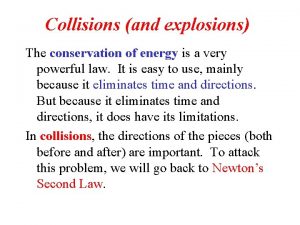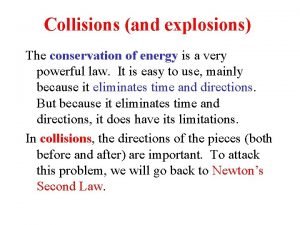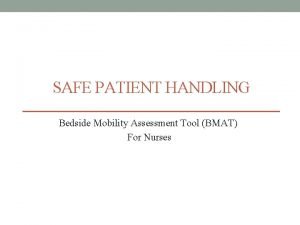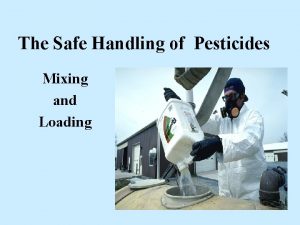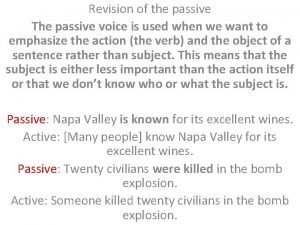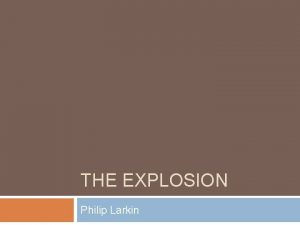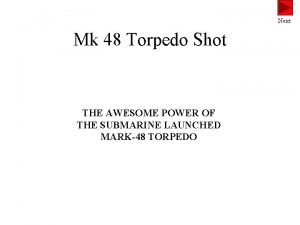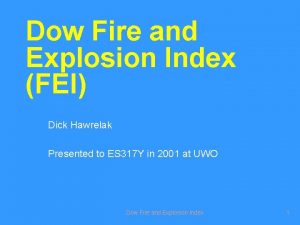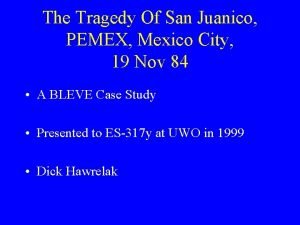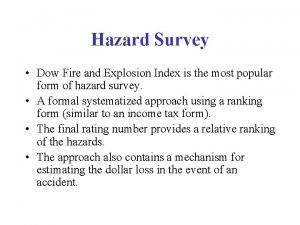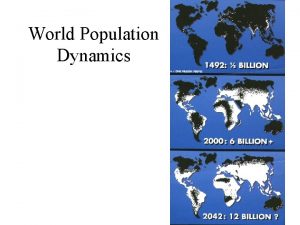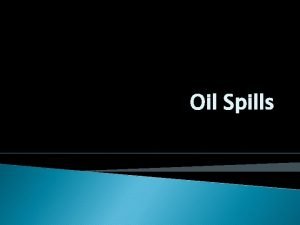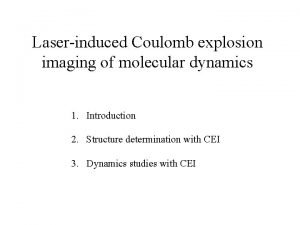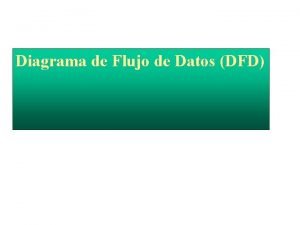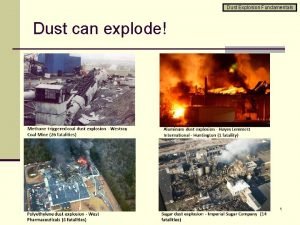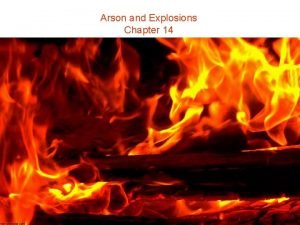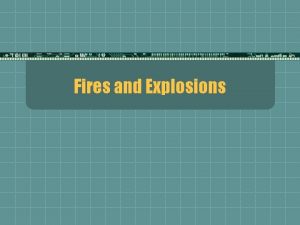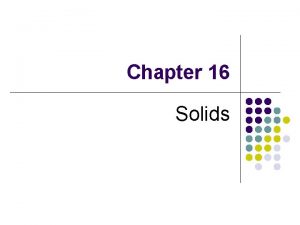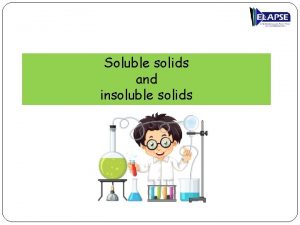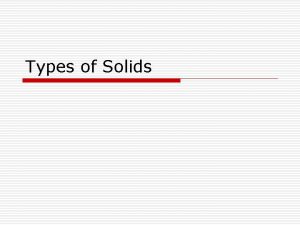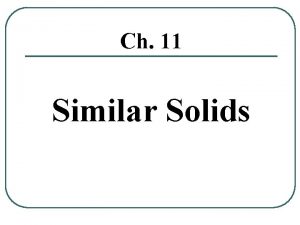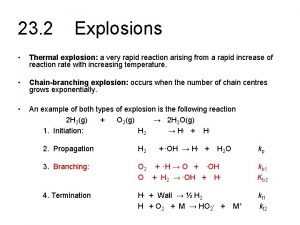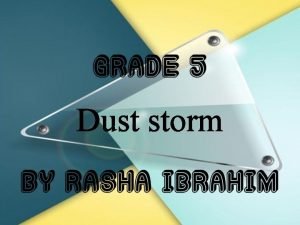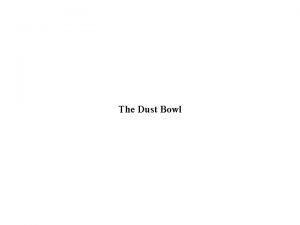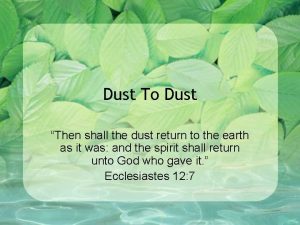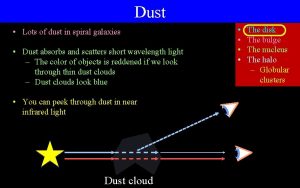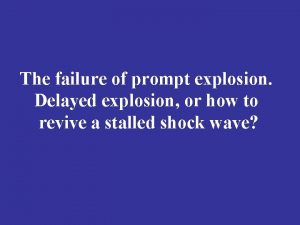Dust Explosions Safe handling of solids Dust Explosion





























- Slides: 29

Dust Explosions Safe handling of solids

Dust Explosion Control Ü Introduction Ü Basic concepts of dust explosions Ü Ignition sources Ü Electrostatic ignitions Ü Deadly Dust II (Video)

Solids Handling Ü The safe handling of solids in becoming more important because the production and the processing of solids is increasing. Ü More chemicals are being produced and handled as solids to eliminate reactions with volatile and hazardous solvents. Ü Emphasis to produce products as powders (versus liquids) to eliminate the need to handle empty containers. Ü More chemicals are transported in reusable “super sacks”

Flammable gases & vapors When dealing with flammable gases and vapors, the generally accepted major requirements for a fire or explosion are fuel, oxygen and ignition. Ü In chemical industry they try to eliminate or reduce one or more of the sides of the triangle. Ü

Explosive Dusts Hexagon For Dust explosions there is a more complex situation needed before an explosion occurs. Fuel – any dust such as, chemicals, grain, wood dust, flour, polymers, lint etc. Ü Moisture – when fuel contains a higher moisture content, then the dust Ü

Explosive Dust Hexagon (cont) Ü Dust and Air Suspension: Particles must be below a certain minimum size to be able to be suspended. Particle loading (concentration) must be between certain limits: – Lower 20 to 60 g/m 3 – Upper 2 to 6 kg/m 3 Dust loading must be fairly uniform to be explosive.

Effects of suspension Ü In the upper picture a bin (with a vent) that contains dust is ignited. Ü In the lower picture, an additional pile of dust was located in the path of the venting flame. Ü The dust become suspended and caused a secondary

Prevention of Dust Explosions Ü Eliminate fuel Ü Prevent dust suspensions Ü Add moisture Ü Keep fuel below LFL Ü Reduce oxygen below MOC Ü Eliminate ignition sources

Flammable Dusts Ü Ü Ü Ü Ü Acetamide Adipic Acid Aluminum Barley Carbon Cellulose Coffee Corn Epoxy Resin Iron Ü Ü Ü Ü Ü Milk Nylon Paper Polystyrene Starch Steel Sucrose Wheat Wood Zinc

Minimum Ignition Energies Ü Dusts Aluminum 10 m. J Corn (2%moisture) 110 m. J Epoxy Resin <10 m. J Milk Powder 50 m. J Sugar 30 m. J Sulphur Ü Versus Vapors Acetone 1 m. J Acrolein 0. 1 m. J Benzene 0. 2 m. J Carbon Disulfide <0. 1 m. J Heptane 0. 2 m. J Toluene

Elimination of suspensions Ü Good housekeeping – If dust is not lying around it cannot get suspended which results in an explosive situation. Ü Dust on beams is especially a problem since an explosion in one part of the facility will cause the dust to be suspended and exacerbate the hazard. Ü Often moisture is added to solids to minimize suspensions and also to reduce explosivity.

Keeping fuel below LFL Ü Venting of area and/or hooding used to collect dust. The collected dust is sent to a collections system such as a bag house, cyclone or electrostatic precipitator to remove and collect the dust. Ü Pelletize solids to minimize amount of material in air suspendable size range. Ü Inerting the area where dust will be present to reduce oxygen to below MOC. Often not practical in large systems. Inerting processes will be discussed at another time.

Common Ignition Sources ÜA United Kingdom study of dust explosions and fires cited the following causes of ignition sources Mechanical 18% Overheating 17% Open flames 15% Static Electricity 11% Welding 7% Electrical 3% Other 29%

Static Electricity Discharges Ü Static electricity is thee fourth largest cause of ignition sources in dust explosions. Ü Because of the nature of solids, the handling and transportation of solids can actually be the cause of the static electricity

Dust Explosion Control Ü Introduction Ü Basic concepts of dust explosions Ü Ignition sources Ü Electrostatic ignitions Accumulation of charges Electrostatic discharges Ü Deadly Dust II (Video)

Fundamentals of Static Electricity Ü Handling solids often leads to the accumulation of static electricity. This accumulation can lead to a spark that then serves as an ignition source. Ü One method to prevent static electricity is to prevent the accumulation of charge. Ü Charge Accumulation: Contact and Frictional Double layer Induction Transport

Contact and Frictional Charging Ü Dust transport e. g. pneumatic transport of powders/solids Ü Pouring powders e. g. pouring solids down chutes or troughs Ü Gears and belts e. g. transporting charges from one surface to another

Double layer charging Ü Caused by friction at interfaces on a microscopic scale. Ü Liquid-liquid Ü Solid-solid Ü Gas-liquid Ü Gas-solid

Induction charging Occurs when an isolated conductor is subject to a electric field. Charges of different polarity are induced on opposite sides. If an earthed electrode touches or approaches the body then the charges closest to electrode flow away leaving the body with a net charge of opposite sign. Ü Occurs by walking across carpet. Ü Nonconductive shoes are a Ü

Charging by Transport Ü Results from a charged dust, liquid or solid particles settling onto a surface and transporting their charges to this new surface. Ü The rate of charge accumulation is a function of the rate of transportation. Ü Lightening is an example of this type of charging phenomenon.

Dust Explosion Control Ü Introduction Ü Basic concepts of dust explosions Ü Ignition sources Ü Electrostatic ignitions Accumulation of charges Electrostatic discharges Ü Deadly Dust II (Video)

Electrostatic Ignitions Ü Static electric ignitions are the result of transferring the accumulated charges to another surface via a discharge. Ü The accumulated charge may be safely leaked away to earth by grounding. Ü If energy of discharge exceeds MIE then fire or explosion. Ü Static electric Discharges Sparks Propagating brush Brush

Spark discharges Ü Discharges between two conductors. Ü Very energetic with energies ranging up to 10 Joules. Ü Can ignite flammable gases and dusts

Propagating brush discharge Occur between a conductor and a nonconductive lining. Ü Very energetic, can be greater than 100 Joules. Ü Major contributor to static electricity ignitions. Ü If breakdown voltage of lining is less than 4 k. V, then propagating brush discharges are not possible because charge will pass through lining. Ü

Brush discharge Ü Ü Ü Occurs between nonconductor and a conductor. Energetic < 5 m. J Nonconductive lining or surface must have a breakdown voltage greater than 4 k. V and a thickness greater than 2 mm. Can ignite flammable vapors but rarely ignites flammable dusts. Nonconductive coating

Corona discharge similar to brush discharge but occurs when electrode more pointed. Ü Occurs over a longer period of time than a spark and may give faint glow and hissing sound. Ü Can cause ignition of flammable gas mixtures with low MIE. Ü Usually considered nonincendive to dusts. Ü

Conical pile discharge (Maurer discharge) Ü Ü Ü Ü Occur between sliding solids and charged air. Vessels larger than 1 m 3. Nonconductive particles with resistance greater than 1010 Ohm • m Particles larger than 1 mm diameter Relatively fast filling rate, greater than 0. 5 kg/s Energetic ~ 1 Joule Can ignite flammable dusts and vapors

Preventing Electrostatic Ignitions Ü Handout gives a thought process procedure to prevent electrostatic ignitions from dust or dust/flammable vapor systems.

Deadly Dusts II Opening scene is an actual explosion captured by a TV photographer filming an Ad. Ü Made for grain handlers and deals primarily with grain silos. Ü To make this video relevant to other industries, every time the work grain is used, substitute it with chemical dusts, flour, starch, pharmaceutical dusts, fibers, polymers, plastics, etc. Ü
 Collisions and explosions
Collisions and explosions Collisions and explosions
Collisions and explosions Safe patient handling
Safe patient handling St lawrence & atlantic railroad
St lawrence & atlantic railroad Bmat mobility
Bmat mobility Safe patient handling algorithms
Safe patient handling algorithms 12 golden rules of gun safety
12 golden rules of gun safety Safe handling of pesticides
Safe handling of pesticides Us powerboating safe powerboat handling
Us powerboating safe powerboat handling Safe feed safe food
Safe feed safe food Safe people safe places
Safe people safe places Fiona told the truth to julian change into passive voice
Fiona told the truth to julian change into passive voice An explosion causes the car to move apart
An explosion causes the car to move apart Philip larkin the explosion
Philip larkin the explosion Share jesus without fear outline
Share jesus without fear outline Torpedo 48 shots
Torpedo 48 shots Tabel nomogram harry king
Tabel nomogram harry king Cambrian explosion
Cambrian explosion Explosion w fei
Explosion w fei Crisis communication skills
Crisis communication skills What does bleve stand for
What does bleve stand for Texas tech chemistry department
Texas tech chemistry department F&ei
F&ei Halifax explosion definition
Halifax explosion definition Data explosion
Data explosion Population explosion
Population explosion Oil spill
Oil spill A sweet sign of affection candy
A sweet sign of affection candy Coulomb explosion imaging
Coulomb explosion imaging Elementos dfd
Elementos dfd
